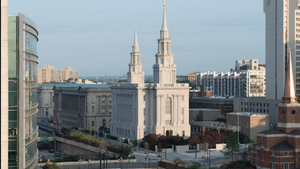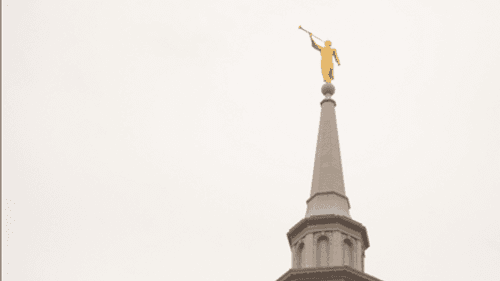Stay in the Loop
BSR publishes on a weekly schedule, with an email newsletter every Wednesday and Thursday morning. There’s no paywall, and subscribing is always free.
It's latter days for public viewing of the new LDS temple
Touring Philadelphia's new Church of Jesus Christ of Latter-day Saints

In large cities like Philadelphia, it’s common to see people in clothing that marks their commitment to particular traditions. We don’t look twice at Amish women in kapps and aprons or bearded Amish men in hats and suspenders. Even those who don’t observe rules about religious garb on a daily basis often do so when entering a place of worship, such as men who don yarmulkes upon entering a synagogue.
The context
Both of these categories — believers expressing their faith in a secular space through their garb, or the gestural ease of passing into a sacred space by covering one’s head or removing one’s shoes — reflect a certain degree of permeability between the sacred and profane. In our ever-more secular society, however, believers who take the concept of sacred space more seriously than this tend to make people nervous.
When the scale of that sacred space increases, as it does when believers erect an enormous building on a prime piece of real estate, the discomfort of nonbelievers may increase concomitantly. And when the group decrees that the space they have created is so sacred it may be entered only by believers — well, that group is often perceived as having something to hide.
One such group is the Church of Jesus Christ of Latter-day Saints (a.k.a. the LDS Church, a.k.a. the Mormons), a group that has had a high-tension relationship with non-Mormon U.S. society since its founding in 1830. (I discussed the significance of the “high/low tension” continuum with regard to the Mormons back in 2012, when Mormon Mitt Romney was running for president in an election that was, interestingly enough, far less “us-vs.-them” on issues of religious identity than the current campaign.)
The Mormons build temples that are accessible only by (literally) card-carrying members of the faith: those with a “recommend” card issued by a church leader. Weekly services are held in meetinghouses, which are open to non-Mormons; the temple is reserved for particularly sacred rituals, known as ordinances. These include, most importantly, baptism (including the baptism of a member’s ancestors) and “sealing,” the marriage ceremony that marks the eternal connection between a man and woman, as well as the children they may have or adopt. Other ceremonies (such as endowment) and activities (such as spiritual instruction and counseling) also take place within the temple.
The building
The LDS church has built 152 temples since its founding. The most recent is at the northeast corner of Philadelphia’s Logan Square, across the Vine Street expressway from the Catholic Cathedral Basilica of Saints Peter and Paul. Implicitly acknowledging the site’s proximity to the iconic swath of the Ben Franklin Parkway, the architects (Perkins + Will and FFKR) eschewed the frequently bunkerlike design of many Mormon temples (see the slideshow here), or the Emerald City retro-futurism of the Washington, DC temple (1974) at which so many of us have goggled.
Instead, the granite-clad building looks like a traditional American church, such as one a kid asked to draw “a church” might limn, albeit one scaled up to 208 feet. The exterior is a little bit Beaux-Arts, to chime with the adjacent Family Court and Free Library buildings, and a little Georgian, evoking the bell tower and steeple of Independence Hall. It avoids picking a fight with the cathedral next door by keeping the overall height (including the gold-leafed 21’2” Angel Moroni atop its east spire) a few inches shorter than that building’s spire.
The building is, however, no more visually permeable than other Mormon temples: Though it has windows, to maintain the privacy of the sacred space within, all the windows are opalescent white art glass with beige and blue accents. The windows do provide natural light within, though of course no views of the profane space outside on Logan Square.
The tour
The church is hosting a monthlong open house prior to the temple’s dedication on September 18. Every-15-minutes tours give Mormons a first look and non-Mormons the opportunity to see for themselves the interior of the building from which they will ultimately be excluded.
On the tours, small groups are shepherded from one functional space to the next, with a member or missionary stationed in each area to give a brief explanation about the activities that will take place there. Other volunteers are placed strategically along the route to ensure no one strays, and provide other kinds of assistance. For instance, guests don disposable shoe covers before entering the temple — not for any ritual reason, it is emphasized, but to protect the rugs from the hundreds of visitors trooping through. One set of fresh-faced youngsters place the booties on visitors’ feet; another set is available at the other end of the tour with trash cans, though visitors can doff the booties for themselves.
The interior has the feeling of a large hotel, an attractive but impersonal space through which many people may pass without developing an ongoing relationship to it. (It’s tempting to connect the hotellike décor to the influence of the Marriott chain — founded and, until 2012, presided over by the Mormon family of the same name — but I think the similarities of appearance are based on the similarities of the function of public/private spaces.)

The color scheme is light but neutral (beige, off-white, and blue) and the overall style is blinged-up “colonial.” Light fixtures are globe-bottomed brass chandeliers in a “colonial” design, crystal chandeliers, and some chandeliers that combine the two. Paneled doors throughout are spiffed up with millwork in a braided design around the edges. The top floor Celestial Room, a place for believers to meditate and perhaps seek revelation from God, combines both Ionic and Corinthian entablature, and is lit by an enormous crystal chandelier. Not my taste — but then, I’m not the target audience. Flower arrangements throughout are artificial.
Most of the paintings are reproductions, though the lobby (with a desk for checking "recommend" cards) features an original depiction of the signing of the Declaration of Independence. The baptism room has an original mural of founder Joseph Smith’s 1829 baptism in Pennsylvania’s Susquehanna River. Artistically, the art is as pleasantly neutral as the building design and décor.
The opening of the Temple is a major development for the 15,000 Mormons in the immediate Philadelphia area (including Channel 10 morning anchor Vai Sikahema) and an additional 26,000 in the region. It’s also a major development for the appearance of Logan Square, whatever the future may bring for it.
What, When, Where
The Philadelphia, Pennsylvania Temple of the Church of Jesus Christ of Latter-day Saints. Through September 9, 2016 at 1739 Vine St., Philadelphia. Ldschurchtemples.com/philadelphia.
Sign up for our newsletter
All of the week's new articles, all in one place. Sign up for the free weekly BSR newsletters, and don't miss a conversation.

 Judy Weightman
Judy Weightman